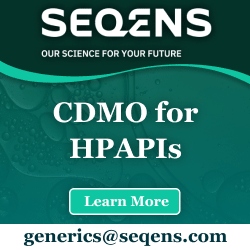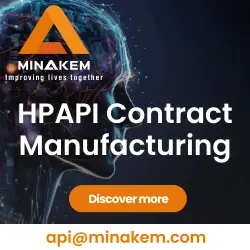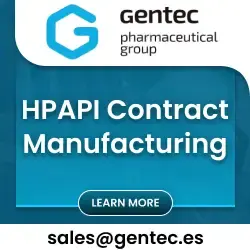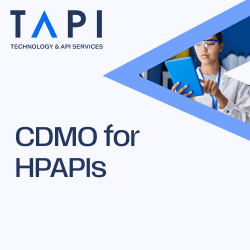BLOG
MARKET INTEL by PharmaCompass
CONTENT by Suppliers
- Interview #SpeakPharma
- Video #SupplierSpotlight
- Vlog #PharmaReel
- Company Bio #AboutSupplier
- Service Bio #AboutCapabilities
News
Create content with us, ask us


- CONTRACT MANUFACTURING
- CYTOTOXIC COMPOUND
- ANTIBIOTIC
- ANTIBODY DRUG CONJUGATE
- BIOLOGICS, BIOPROCESS & FERMENTATION
- CHIRAL SYNTHESIS
- CLINICAL SUPPLY
- CONTINUOUS FLOW PROCESS
- CONTROLLED SUBSTANCE
- CUSTOM SYNTHESIS & MANUFACTURING
- DISTILLATION / LIQUID API
- DRYING
- FINE CHEMICAL / INTERMEDIATE
- GMP MANUFACTURING
- HALOGENATION
- HAZARDOUS CHEMISTRY
- HIGH POTENCY APIS (HPAPIS)
- HIGH PRESSURE REACTION (> 100 PSI)
- HIGH TEMPERATURE REACTION (> 200 °C)
- HYDROGENATION
- LOW TEMPERATURE / CRYOGENIC CONDITIONS
- LYOPHILIZATION
- MICRONIZATION
- ORGANOMETALLIC CHEMISTRY
- OZONOLYSIS
- PHOSGENATION
- PLANT EXTRACTION
- PROBIOTIC
- PROCESS DEVELOPMENT & OPTIMIZATION
- PROCESS SAFETY ASSESSMENT
- PROTEIN / PEPTIDE
- REFERENCE STANDARD
- RESOLUTION OF RACEMIC MIXTURE
- SCALE UP
- SEPARATION & PURIFICATION
- SMALL SCALE BATCH
- INJECTABLE / STERILE APIS
- STEROID / HORMONE
- VITAMINS / MINERALS / INORGANIC SALTS
- CHROMATOGRAPHY
- OLIGOSACCHARIDES & POLYSACCHARIDES
- SMALL MOLECULES
- OLIGONUCLEOTIDE / POLYNUCLEOTIDE
- BIOPOLYMERS

01 Overview
02 Overview
03 Overview
04 Overview
05 Overview
06 Overview
07 Overview
08 Overview
09 Overview
10 Overview
11 Overview
12 Overview
13 Overview
14 Overview
15 Overview
16 Overview
17 Overview
18 Overview
19 Overview
20 Overview
21 Overview
22 Overview
23 Overview

01 Aarti Pharmalabs
02 AbbVie Contract Manufacturing
03 Aesica Pharmaceuticals Limited
04 Ami Lifesciences Private Limited
05 Angelini Pharma
06 Ardena
07 Arevipharma
08 Ash Stevens
09 Aspen API
10 Aurigene Pharmaceutical Services
11 Axplora
12 Bioquim
13 CARBOGEN AMCIS AG
14 Cambrex Corporation
15 Cerbios-Pharma SA
16 ChemCon GmbH
17 Cohance Lifesciences
18 Curia
19 DOTTIKON EXCLUSIVE SYNTHESIS AG
20 Dishman Carbogen Amcis
21 Egis Pharmaceuticals PLC
22 Esteve Quimica
23 Eurofins CDMO
24 Evonik
25 Evotec
26 Fareva
27 Farmhispania
28 Fermion Oy
29 Fresenius Kabi Austria
30 Gentec Pharmaceutical Group
31 Indena
32 Mac-Chem Products (India) Pvt.Ltd
33 Magle Chemoswed
34 Malladi Drugs & Pharmaceuticals Limited
35 Medichem S.A
36 Minakem
37 Olon S.p.A
38 Pfanstiehl
39 Pfizer CentreOne
40 Piramal Pharma Solutions
41 Polpharma
42 Porton Pharma Solutions
43 Procos
44 ScinoPharm Taiwan Ltd
45 Seqens
46 Servier
47 Siegfried AG
48 Stason Pharmaceuticals, Inc.
49 TAPI Technology & API Services
50 Veranova

01 Austria
02 Belgium
03 China
04 Finland
05 France
06 France
07 France
08 Germany
09 Germany
10 Germany
11 Hungary
12 India
13 India
14 India
15 India
16 India
17 India
18 Israel
19 Italy
20 Luxembourg
21 Netherlands
22 Poland
23 Spain
24 Spain
25 Spain
26 Spain
27 Sweden
28 Switzerland
29 Taiwan
30 U.S.A
31 U.S.A
32 U.S.A
33 U.S.A
34 U.S.A
35 United Kingdom
- Analytical > Analytical Method Development
- Analytical > Analytical Testing Services > Inhalation Products
- Analytical > BioAnalytical Services
- API & Drug Product Development > API Development
- API & Drug Product Development > API Development > Antibody Drug Conjugate
- API & Drug Product Development > API Development > Fine Chemical / Intermediate
- API & Drug Product Development > API Development > High Potency APIs (HPAPIs)
- API & Drug Product Development > API Development > Impurity / Reference Standard
- API & Drug Product Development > API Development > Oligonucleotide / Polynucleotide
- API & Drug Product Development > API Development > Oligosaccharides & Polysaccharides
- API & Drug Product Development > API Development > Overview
- API & Drug Product Development > API Development > Process Development & Optimization
- API & Drug Product Development > API Development > Protein / Peptide
- API & Drug Product Development > API Development > Separation & Purification
- API & Drug Product Development > API Development > Small Molecules
- API & Drug Product Development > API Development > Spray Drying
- API & Drug Product Development > Formulation Development
- API & Drug Product Development > Formulation Development > Buccal / Orodispersible
- API & Drug Product Development > Formulation Development > Capsule
- API & Drug Product Development > Formulation Development > Chewable / Suckable
- API & Drug Product Development > Formulation Development > Clinical Supply
- API & Drug Product Development > Formulation Development > Compounding
- API & Drug Product Development > Formulation Development > Controlled / Immediate / Modified Release
- API & Drug Product Development > Formulation Development > Controlled Substance
- API & Drug Product Development > Formulation Development > Granule / Pellets
- API & Drug Product Development > Formulation Development > Inhalation / Nasal
- API & Drug Product Development > Formulation Development > Injectable / Parenteral
- API & Drug Product Development > Formulation Development > Liquid Formulation
- API & Drug Product Development > Formulation Development > Lyophilization
- API & Drug Product Development > Formulation Development > Ophthalmic
- API & Drug Product Development > Formulation Development > Pediatric Formulation
- API & Drug Product Development > Formulation Development > Scale-Up Capabilities
- API & Drug Product Development > Formulation Development > Sterile Liquid Formulation
- API & Drug Product Development > Formulation Development > Suspension
- API & Drug Product Development > Formulation Development > Tablet
- API & Drug Product Development > Formulation Development > Topical
- API & Drug Product Development > Preformulation & Material Science > Particle Size Reduction & Micronization
- API & Drug Product Development > Preformulation & Material Science > Polymorph & Crystal Screening
- API & Drug Product Development > Preformulation & Material Science > Solubility Assessment & Enhancement
- API & Drug Product Development > Preformulation & Material Science > Taste Masking
- API Manufacturing > Antibiotic
- API Manufacturing > Antibody Drug Conjugate
- API Manufacturing > Biologics, Bioprocess & Fermentation
- API Manufacturing > Chiral Synthesis
- API Manufacturing > Clinical Supply
- API Manufacturing > Continuous Flow Process
- API Manufacturing > Contract Manufacturing
- API Manufacturing > Controlled Substance
- API Manufacturing > Custom Synthesis & Manufacturing
- API Manufacturing > Cytotoxic Compound
- API Manufacturing > Drying > Spray Drying
- API Manufacturing > Fine Chemical / Intermediate
- API Manufacturing > GMP Manufacturing
- API Manufacturing > Hazardous Chemistry
- API Manufacturing > High Potency APIs (HPAPIs)
- API Manufacturing > Micronization
- API Manufacturing > Oligonucleotide / Polynucleotide
- API Manufacturing > Oligosaccharides & Polysaccharides
- API Manufacturing > Organometallic Chemistry
- API Manufacturing > Organometallic Chemistry > Cyanation
- API Manufacturing > Organometallic Chemistry > Metal Hydride Reduction
- API Manufacturing > Ozonolysis
- API Manufacturing > Process Development & Optimization
- API Manufacturing > Protein / Peptide > Synthesis
- API Manufacturing > Reference Standard
- API Manufacturing > Scale Up
- API Manufacturing > Separation & Purification
- API Manufacturing > Small Molecules
- Clinical Trials > Compliance, Regulatory & Consulting
- Clinical Trials > Packaging & Logistics
- Clinical Trials > Medical Writing & Language Translation
- Clinical Trials > Patient / Investigator Recruitment
- Clinical Trials > Technology / Data / Analytics
- Drug Product Manufacturing > Biologic Drugs
- Drug Product Manufacturing > Capsule
- Drug Product Manufacturing > Capsule > Steroid / Hormone
- Drug Product Manufacturing > Compounding
- Drug Product Manufacturing > Cream / Lotion / Ointment
- Drug Product Manufacturing > Emulsion > Overview
- Drug Product Manufacturing > Gel > Overview
- Drug Product Manufacturing > Granule / Pellet
- Drug Product Manufacturing > Injectable / Parenteral
- Drug Product Manufacturing > Injectable / Parenteral > Overview
- Drug Product Manufacturing > Injectable / Parenteral > Pre-Filled Syringe
- Drug Product Manufacturing > Liquid
- Drug Product Manufacturing > Lyophilization
- Drug Product Manufacturing > Nasal
- Drug Product Manufacturing > Softgel Capsule
- Drug Product Manufacturing > Solution > Overview
- Drug Product Manufacturing > Spray
- Drug Product Manufacturing > Suppository
- Drug Product Manufacturing > Suspension > Overview
- Drug Product Manufacturing > Syrup
- Drug Product Manufacturing > Tablet
- Drug Product Manufacturing > Technologies
- Drug Product Manufacturing > Technologies > Orally Disintegrating Tablets (ODTs)
- Drug Product Manufacturing > Technologies > Taste Masking
- Packaging > Clinical Services
- Packaging > Contract Services
- Packaging > Contract Services > Serialization Compliance
- Packaging > Logistic Services
- Empty Capsules
- Empty Capsules > Clinical Supply
- Empty Capsules > HardGel
- Empty Capsules > Inhalation
- Emulsifying Agents
- Soft Gelatin
- Solubilizers
Overview of highly potent APIs & leading CMOs, CDMOs offering HPAPI development & commercial manufacture among other highly potent API services.
Q1. What is a Highly Potent API (HPAPI)?
Highly potent APIs (HPAPIs) are compounds that elicit a biological response at a very low dose. A compound is generally classed as highly potent if it has an occupational exposure limit (OEL) of less than or equal to 10 micrograms/m3 and a daily therapeutic dose of less than or equal to 10mg/day. Highly potent drugs represent a growing proportion of medicines, including therapies in development and those that are commercially available.
However, any type of compound can be highly potent if it causes a response at a low dose. Typically, a compound can be considered 'highly potent' if the therapeutic dose is less than 1 mg. Traditional examples of HPAPIs are cytotoxic compounds and sex hormones such as estrogen. A few examples of commercial products that fall into the highly potent category are digoxin and alprazolam.
HPAPIs are classified based on their toxicity, pharmacological potency and occupational exposure limits (OELs). They are frequently characterized by complex structures requiring multi-step processes or semi-synthesis, often involving more than 10 steps.
Clinical successes and growing press surrounding small molecules focused on oncology indications and cancer growth inhibitors has created somewhat of a gold rush of commercial interest in highly potent active pharmaceutical ingredients (HPAPIs) and biologic–HPAPI conjugate manufacturing.
The chemistry to make such molecules is not necessarily difficult, however, the greater challenge is in highly potent APIs handling and containment to ensure operator and environmental safety. The main advantage of outsourcing highly potent API (HPAPI) manufacture is that it eliminates the need to invest in expensive containment infrastructure, which can also be complex to engineer, install and maintain.
An increase in the clinical pipeline of HPAPIs, ADCs and biologic–HPAPI conjugates have changed the demands on contract manufacturing service providers such as CMOs and increased the need for highly potent APIs.
Q2. How are HPAPIs classified using OEB strategies?
There is no standard for the definition of a highly potent active pharmaceutical ingredient (HPAPI) because classification systems vary across companies and regions. The most common methods for classifying these compounds rely on control banding strategies, which categorize APIs based on occupational exposure limits (OELs).
An occupational exposure limit (OEL) is the maximum allowable concentration of a hazardous substance in a workplace. It is defined as the upper limit of concentration in the air. These limits have been set in many countries by the overseeing government department. Once an OEL is identified, the API is placed into the appropriate occupational exposure band (OEB).
Occupational exposure banding, also known as hazard banding, is a process intended to quickly and accurately assign chemicals into specific categories (bands), which correspond to a range of exposure concentrations designed to protect worker health.
Typically, OEB systems categorise compounds from low to high potency and define the handling and containment requirements dependent upon the OEB category. Occupational exposure bands are classified into four types of risk levels. These OEB levels are explored in detail below.
- OEB 1
This is the lowest OEB level, where the toxicity of the material does not present a hazard to the operator. Therefore, it requires the lowest level of containment as the chemicals don’t pose any threat to the worker’s safety.
- OEB 2
At this OEB level there is a minor risk from the toxicity of the material. Pragmatic steps should be taken to prevent uncontrolled operator exposure. This level necessitates good manufacturing safeguards with local exhaust ventilation.
- OEB 3
At this OEB level, the material is mildly hazardous, hence measures should be taken to prevent operator exposure. There should be no open handling and ventilated enclosures and containment systems should be in place.
- OEB 4
At this OEB level, the material is highly hazardous, hence significant measures should be taken to prevent operator exposure. There should be a permanent physical barrier between the operator and the material. The process should be completely enclosed and barrier and isolation technologies are required.
- OEB5
At times, APIs could be classified as OEB 5 in a five-band occupational exposure banding system. It implies that an Active Pharmaceutical Ingredient (API) is highly potent, has significant adverse effects at low doses, and may be genotoxic, carcinogenic, or have reproductive effects at relevant doses.
Controlling occupational exposure to OEB 5 compounds is difficult. It requires the highest level of containment, such as isolators, that involves no open handling, closed transfers through validated systems, and the most skilled operators.
Q3. What are some different containment and handling issues associated with High-Potency APIs (HPAPIs)?
HPAPIs, in particular, small molecules being developed for oncology present a new set of challenges for CMOs charged with safe handling and containment during process development and clinical and commercial production of an HPAPI – Highly Potent API.
- Employee exposure to HPAPIs is typically the primary concern for manufacturers. As such, it is essential to put a thorough cleaning programme in place to avoid contaminating surfaces and establish a safe working environment for employees. Additionally, good practice in occupational safety recommends implementing a medical surveillance and monitoring programme.
- It is vital that a careful assessment is made of the hazards posed by each individual product, reagent, and intermediate involved in the synthesis ahead of manufacture. If the risks are underestimated, people within and around the plant will be in danger. Conversely, if the risks are overestimated, the result will be excessive amounts of money spent on containment and an increase in project costs.
- The cytotoxic nature of an HPAPI – Highly Potent API presents significant handling challenges and thus requires heavy investments for implementing specialized containment facilities that facilitate the safety of employees from exposure. Adding these capabilities internally is expensive, time consuming, and risky. Furthermore, choosing the right partner for outsourcing HPAPI development and manufacturing of active pharmaceutical ingredients, specifically highly potent APIs can be a challenge.
- The early HPAPI (Highly Potent API) development phase of a project sometimes creates a challenge for categorization, and sufficient information is not always available to allow for a clear assessment of exposure risks. Therefore, extensive knowledge and experienced personnel are required for successful HPAPI (Highly Potent API) development.
- Besides the safety of employees and the protection of the environment, the protection of the API itself from contamination or cross contamination from other HPAPIs made in the facility or the site is a challenge. This risk can come from both previous and concurrent operations and most firms do not have the luxury of a dedicated plant which increases the risk of contaminations.
Working with an experienced pharmaceutical outsourcing organization such as a CMO or CDMO can help eliminate the above mentioned challenges such as investing in costly infrastructure and the cost of training personnel for the production of an HPAPI – Highly Potent API.
Q4. Which are the leading pharmaceutical CMOs offering Highly Potent APIs?
Various Contract Manufacturing Organizations (CMOs) which have HPAPI manufacturing capabilities can provide highly potent API services as well as manufacturing of active pharmaceutical ingredients (highly potent) and ultimately function as a highly potent API producer.
The different contract services may include HPAPI development, biologic–HPAPI conjugate manufacturing, large-scale highly potent API manufacturing or the commercial manufacture of highly potent compounds, etc.
Some Leading CMOs offering Highly Potent APIs:
Wavelength Pharmaceuticals - High Potency API Manufacturing
Wavelength Pharmaceuticals offers contract manufacturing services for the production of highly potent active pharmaceutical ingredients (HPAPIs) along with steroids and cytotoxic compounds. It has developed robust commercial scale processes including large scale highly potent API manufacturing or the commercial manufacture of highly potent compounds.
Eurofins CDMO - High-potency APIs (HPAPIs) Manufacturing
Eurofins CDMO offers integrated contract manufacturing services through the entire drug product life cycle. It has HPAPI manufacturing capabilities and thereby offers highly potent active pharmaceutical ingredients (HPAPIs). Furthermore, its cGMP manufacturing plant provides highly potent APIs handling and other contract services, thus establishing it as a highly potent API producer and service provider.
Pfizer CentreOne - High Potency API Manufacturing
Pfizer offers manufacturing expertise for potent drugs, liquid cytotoxics, biologics, controlled substances (II-IV), liposomal, inactivated vaccines, monobactam, etc. It also provides contract services for HPAPI development and manufacturing of active pharmaceutical ingredients such as small molecules, hormones, steroids and prostaglandins .
Minakem - High-potency API (HPAPI) Development & Manufacturing
Minakem offers a state-of-the-art high containment facility for highly potent API manufacturing equipped to handle highly potent API services from early-stage HPAPI (Highly Potent API) development to scale-up and commercial manufacture of highly potent compounds (large scale highly potent API manufacturing).
Medichem S.A - High Potency API Manufacturing
Medichem has HPAPI manufacturing capabilities at its API plant in Malta. It produces Class 4 HPAPIs within cGMP and FDA inspected environments. It has an R&D lab as well as a kilo-lab and can thus offer both development and manufacturing contract services. Medichem provides highly potent API services and thus functions as a highly potent API producer.
All Suppliers
01
Pharma Service : API Manufacturing
02
Pharma Service : API Manufacturing
03
Pharma Service : API Manufacturing
04
Pharma Service : API Manufacturing
05
Pharma Service : API Manufacturing
MANUFACTURING OF HIGHLY POTENT APIs
Category : High Potency APIs (HPAPIs)
Sub Category : Overview
Pharma Service : API Manufacturing
06
Pharma Service : API Manufacturing
07
Pharma Service : API Manufacturing
HIGHLY POTENT API MANUFACTURING
Category : High Potency APIs (HPAPIs)
Sub Category : Overview
Pharma Service : API Manufacturing
08
Pharma Service : API Manufacturing
CMO FOR HIGH POTENCY APIs (HPAPIs)
Category : High Potency APIs (HPAPIs)
Sub Category : Overview
Pharma Service : API Manufacturing
09
Pharma Service : API Manufacturing
HPAPI CONTRACT MANUFACTURING SERVICES
Category : High Potency APIs (HPAPIs)
Sub Category : Overview
Pharma Service : API Manufacturing
10
Pharma Service : API Manufacturing
CONTRACT MANUFACTURING FOR HPAPIs
Category : High Potency APIs (HPAPIs)
Sub Category : Overview
Pharma Service : API Manufacturing
11
Pharma Service : API Manufacturing
HIGHLY POTENT API MANUFACTURING
Category : High Potency APIs (HPAPIs)
Sub Category : Overview
Pharma Service : API Manufacturing
12
Pharma Service : API Manufacturing
CONTRACT MANUFACTURING FOR HPAPIs
Category : High Potency APIs (HPAPIs)
Sub Category : Overview
Pharma Service : API Manufacturing
13
Pharma Service : API Manufacturing
14
Pharma Service : API Manufacturing
15
Pharma Service : API Manufacturing
CONTRACT MANUFACTURING FOR HIGH POTENCY ...
Category : High Potency APIs (HPAPIs)
Sub Category : Overview
Pharma Service : API Manufacturing
16
Pharma Service : API Manufacturing
17
Pharma Service : API Manufacturing
CONTRACT MANUFACTURING FOR LIQUID CYTOTO...
Category : High Potency APIs (HPAPIs)
Sub Category : Overview
Pharma Service : API Manufacturing
18
Pharma Service : API Manufacturing
19
Pharma Service : API Manufacturing
HIGHLY POTENT API MANUFACTURING
Category : High Potency APIs (HPAPIs)
Sub Category : Overview
Pharma Service : API Manufacturing
20
Pharma Service : API Manufacturing
CONTRACT MANUFACTURING FOR HPAPIs
Category : High Potency APIs (HPAPIs)
Sub Category : Overview
Pharma Service : API Manufacturing
21
Pharma Service : API Manufacturing
MANUFACTURING OF HIGHLY POTENT APIs (HPA...
Category : High Potency APIs (HPAPIs)
Sub Category : Overview
Pharma Service : API Manufacturing
22
Pharma Service : API Manufacturing
CONTRACT MANUFACTURING FOR HPAPIs
Category : High Potency APIs (HPAPIs)
Sub Category : Overview
Pharma Service : API Manufacturing
23
Pharma Service : API Manufacturing
HPAPI DEVELOPMENT & COMMERCIAL PRODUCTIO...
Category : High Potency APIs (HPAPIs)
Sub Category : Overview
Pharma Service : API Manufacturing
24
Pharma Service : API Manufacturing
Medichem produces Class 4 HPAPIs with OEL down to 40 ng/m³ in its state-of-the-art cGMP facilities.
Category : High Potency APIs (HPAPIs)
Sub Category : Overview
Pharma Service : API Manufacturing
25
Pharma Service : API Manufacturing
26
Pharma Service : API Manufacturing
HIGHLY POTENT API (HPAPI) MANUFACTURING
Category : High Potency APIs (HPAPIs)
Sub Category : Overview
Pharma Service : API Manufacturing
27
Pharma Service : API Manufacturing
28
Pharma Service : API Manufacturing
HIGH POTENCY API (HPAPI) MANUFACTURING
Category : High Potency APIs (HPAPIs)
Sub Category : Overview
Pharma Service : API Manufacturing
29
Pharma Service : API Manufacturing
30
Pharma Service : API Manufacturing
HIGH POTENCY CYTOTOXICS INJECTABLE APIs
Category : High Potency APIs (HPAPIs)
Sub Category : Overview
Pharma Service : API Manufacturing
31
Pharma Service : API Manufacturing
HIGHLY POTENT API (HPAPI) MANUFACTURING
Category : High Potency APIs (HPAPIs)
Sub Category : Overview
Pharma Service : API Manufacturing
32
Pharma Service : API Manufacturing
CONTRACT MANUFACTURING FOR HIGHLY POTENT...
Category : High Potency APIs (HPAPIs)
Sub Category : Overview
Pharma Service : API Manufacturing
33
Pharma Service : API Manufacturing
HANDLING OF HIGHLY POTENT COMPOUNDS
Category : High Potency APIs (HPAPIs)
Sub Category : Overview
Pharma Service : API Manufacturing
34
Pharma Service : API Manufacturing
HIGH POTENCY API MANUFACTURING
Category : High Potency APIs (HPAPIs)
Sub Category : Overview
Pharma Service : API Manufacturing
35
Pharma Service : API Manufacturing
HIGHLY POTENT API (HPAPI) MANUFACTURING
Category : High Potency APIs (HPAPIs)
Sub Category : Overview
Pharma Service : API Manufacturing
36
Pharma Service : API Manufacturing
37
Pharma Service : API Manufacturing
MANUFACTURING OF HIGHLY POTENT COMPOUNDS
Category : High Potency APIs (HPAPIs)
Sub Category : Overview
Pharma Service : API Manufacturing
38
Pharma Service : API Manufacturing
CMO FOR HIGH POTENCY APIs (HPAPIs)
Category : High Potency APIs (HPAPIs)
Sub Category : Overview
Pharma Service : API Manufacturing
39
Pharma Service : API Manufacturing
HIGH POTENT APIs (HPAPI) MANUFACTURING
Category : High Potency APIs (HPAPIs)
Sub Category : Overview
Pharma Service : API Manufacturing
40
Pharma Service : API Manufacturing
41
Pharma Service : API Manufacturing
CONTAINMENT FACILITIES TO PRODUCE HPAPIs
Category : High Potency APIs (HPAPIs)
Sub Category : Overview
Pharma Service : API Manufacturing
42
Pharma Service : API Manufacturing
43
Pharma Service : API Manufacturing
HIGH POTENCY API MANUFACTURING
Category : High Potency APIs (HPAPIs)
Sub Category : Overview
Pharma Service : API Manufacturing
44
Pharma Service : API Manufacturing
HIGH POTENCY API MANUFACTURING
Category : High Potency APIs (HPAPIs)
Sub Category : Overview
Pharma Service : API Manufacturing
45
Pharma Service : API Manufacturing
46
Pharma Service : API Manufacturing
MANUFACTURING HIGHLY POTENT COMPOUNDS
Category : High Potency APIs (HPAPIs)
Sub Category : Overview
Pharma Service : API Manufacturing
47
Pharma Service : API Manufacturing
HIGH POTENCY API HANDLING- GRAMS TO TONS
Category : High Potency APIs (HPAPIs)
Sub Category : Overview
Pharma Service : API Manufacturing
48
Pharma Service : API Manufacturing
MANUFACTURING OF HIGH POTENT APIs
Category : High Potency APIs (HPAPIs)
Sub Category : Overview
Pharma Service : API Manufacturing
49
Pharma Service : API Manufacturing
50
Pharma Service : API Manufacturing
51
Pharma Service : API Manufacturing
HIGH CONTAINMENT FACILITIES AND CAPABILI...
Category : High Potency APIs (HPAPIs)
Sub Category : Overview
Pharma Service : API Manufacturing









 Seqens is an integrated global leader in pharmaceutical solutions & specialty ingredients, & custom-made solutions to our customers.
Seqens is an integrated global leader in pharmaceutical solutions & specialty ingredients, & custom-made solutions to our customers.




























